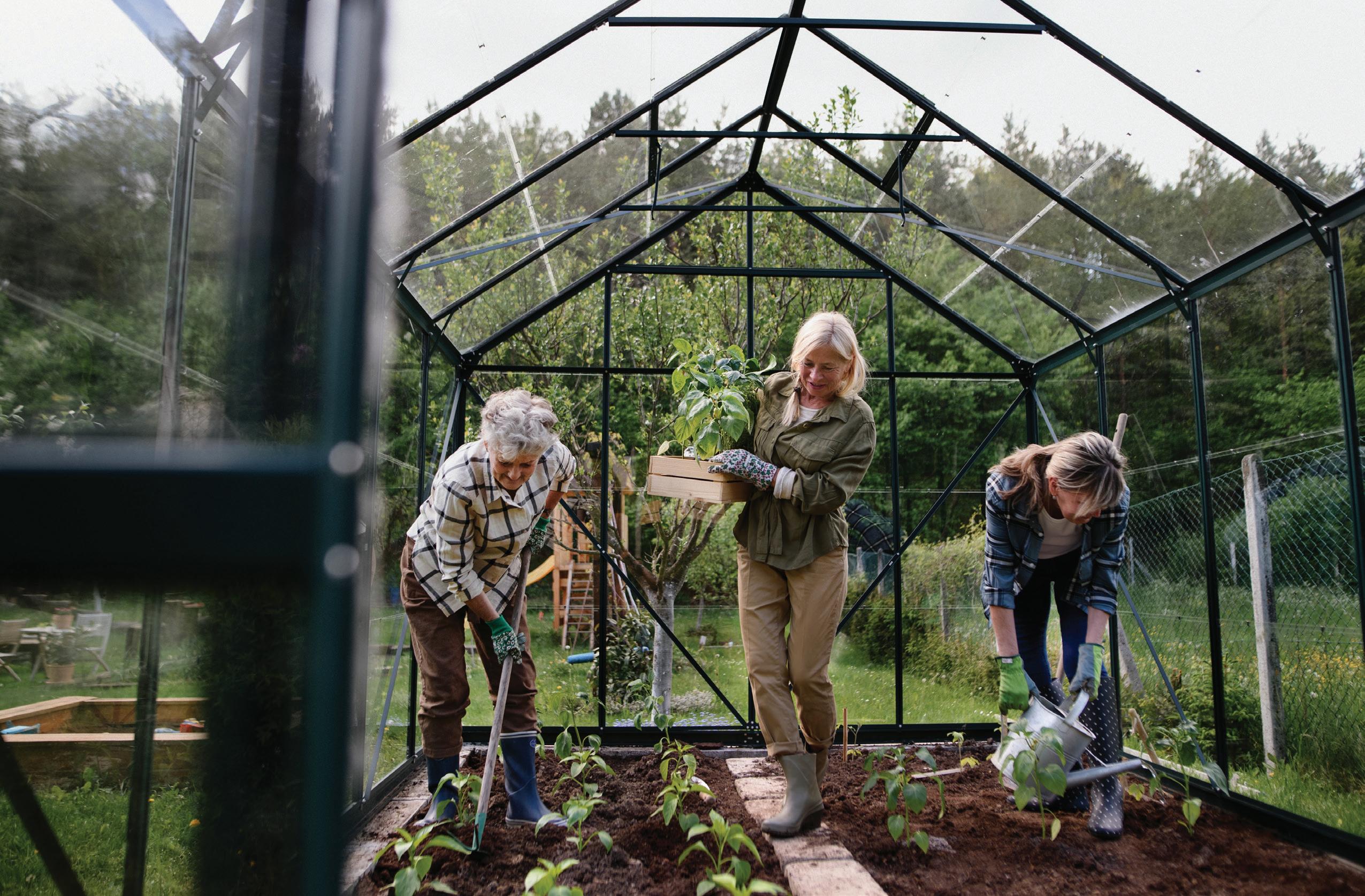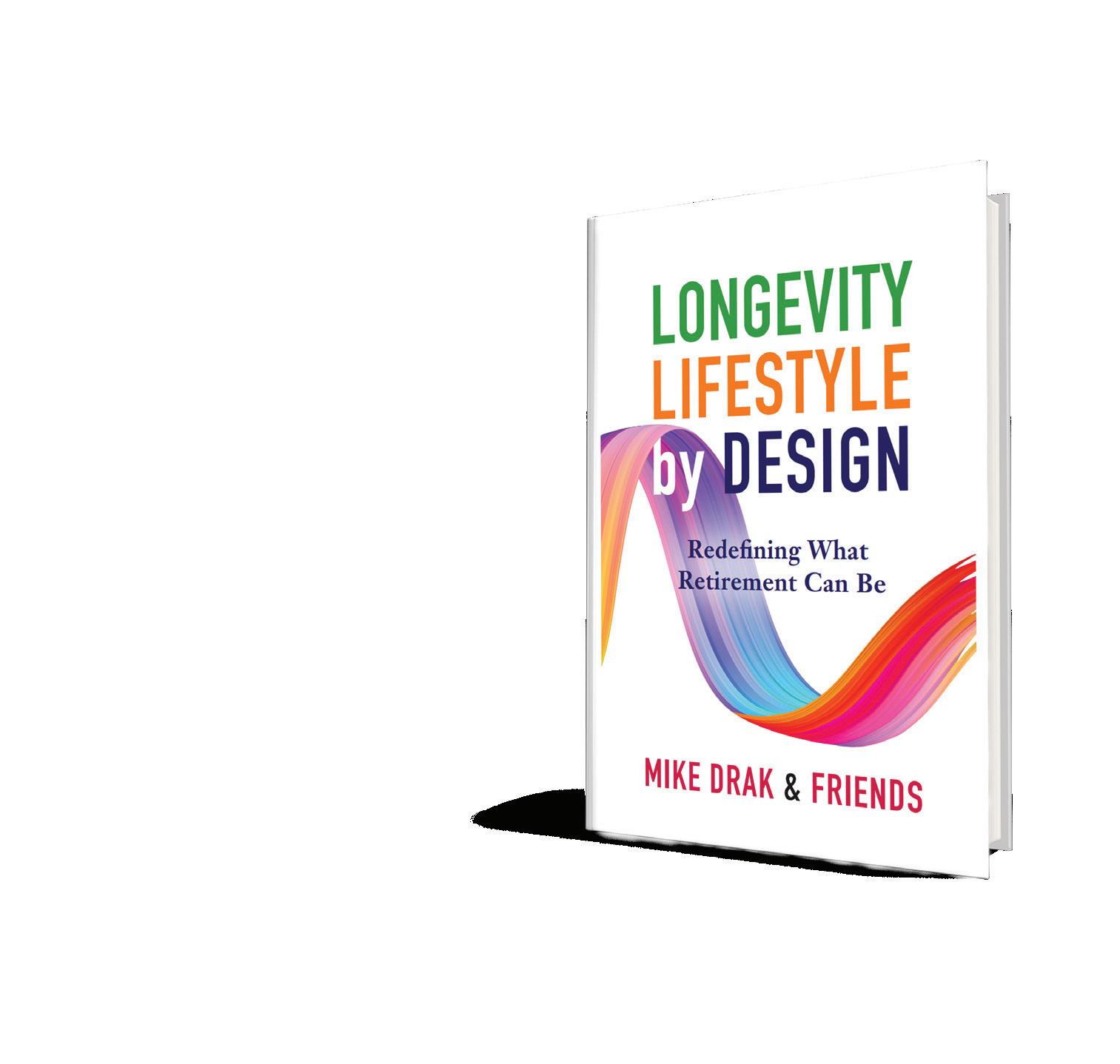
Your one-stop shop to everything retirement! THE GREAT CANADIAN
CHIP REVERSE MORTGAGE AND RETIREMENT EXPERTS Featuring Pattie Lovett-Reid and Joyce Wayne INSIDE
RETIREMENT RESOURCE GUIDE
TABLE OF CONTENTS
How to renovate your home to fit your physical needs
2 | THE GREAT CANADIAN RETIREMENT RESOURCE GUIDE | 1-888-616-4052
INTRODUCTION FINANCES IN RETIREMENT Government retirement income sources Personal retirement income sources Retirement tax benefits How you can enjoy retirement on your terms with CHIP Reverse Mortgage TALKING MONEY WITH PATTIE LOVETT-REID Budgeting in different economic scenarios Budgeting tips Funding your retirement − E xploring Home Equity Options in Retirement 6 8-10 10-12 12 13 14 15-16 17 18-19
IN RETIREMENT
HEALTH
How to prevent falls − and why it matters
Looking after your eyesight
retirement
Looking after your brain health in
Maintaining good mental health
HOMECARE IN RETIREMENT
support 20-21 22-23 24-25 26-27 28-29 30-31 32-34 35-37 4-5
At-home health
THE GREAT CANADIAN RETIREMENT RESOURCE GUIDE | 3 MASTERING AND ADOPTING TECHNOLOGY IN RETIREMENT Getting your tech skills up to speed There is a retirement app for that How technology can help keep you healthy Technology updates specifically for retirees WORKING IN RETIREMENT Reasons why many Canadians are choosing “unretirement” Why retirees are working for themselves Resources for retirees who want (or need) to work JOYCE’S CORNER Relationships Keep you Happy and Healthy during Retirement Lifestyle and Aging – How to Enhance and Protect the Way You Live GLOSSARY 38-39 40-41 42-43 43-44 45 46-47 48-49 50 50-51 52-53 53-55 56-59 60

4 | THE GREAT CANADIAN RETIREMENT RESOURCE GUIDE | 1-888-616-4052 INTRODUCTION
Retirement can be a really liberating time in your life! Often referred to as your ‘golden years’, it’s a time when you’re finally able to fill your days with your interests and passions, without worrying about the grind of work. It’s an exciting time, but like most major changes in life, it can also be nerve racking. You may be worried about your health and finances, and thinking about the ways you can achieve a fulfilling retirement. That’s why we created this guide, because we believe that everyone deserves to retire on their terms, in the home that they love.
Discover the ultimate guide to living your best retirement! The guide is packed with invaluable information on managing your finances, leveraging technology to simplify your life, and taking care of your mental and physical well-being. Plus, we’ll show you how to tap into resources and services that can help you stay in the home you love for years to come. That’s not all! We’ll also explore exciting opportunities for new careers and self-employment that can be pursued in your retirement years.
We hope this guide will deliver the insights you need to feel comfortable in your decision making as you plan for, and begin to enjoy your golden years.

THE GREAT CANADIAN RETIREMENT RESOURCE GUIDE | 5
CHIP Reverse Mortgage Team 1-888-616-4052


6 | THE GREAT CANADIAN RETIREMENT RESOURCE GUIDE | 1-888-616-4052 FINANCES IN RETIREMENT Exclusive Insights from Chief Financial Commentator, Pattie Lovett-Reid

THE GREAT CANADIAN RETIREMENT RESOURCE GUIDE | 7
As you say goodbye to the career that you’ve built over the years, you no longer have that steady stream of income to rely on. Instead, you rely on your savings, investments and/or government and private pensions to cover your living expenses. Without a stable income from a job, it can be a challenge to ensure that you have enough money to see through retirement. In this section, we look at government and private pension options to help you get a sense of the income sources you’ll have once you retire. We will also explore tax benefits applicable to retirees and solicit advice from our Chief Financial Commentator, Pattie Lovett-Reid, on budgeting and using your home equity to finance your retirement.
GOVERNMENT RETIREMENT INCOME SOURCES
First, let’s explore the various government retirement income resources available to help fund your retirement.

CANADA PENSION PLAN (CPP) / QUEBEC PENSION PLAN (QPP)
You may be familiar with Canada Pension Plan (CPP) and/or Quebec Pension Plan (QPP) if you live in Quebec. Some exceptions apply, but every person over the age of 18 who works in Canada (Quebec for QPP) and earns more than the minimum amount of $3,500 per year, must contribute to CPP. So, over the years, you may have made some contributions, and it’s now time to draw from the contributions that you made. We will share with you how CPP is calculated and how to maximize your CPP.
8 | THE GREAT CANADIAN RETIREMENT RESOURCE GUIDE | 1-888-616-4052
FINANCES IN RETIREMENT
Finance is one of the most important factors to consider in retirement.
Canada Pension Plan is one of the main sources of government-sponsored retirement income. It’s a monthly, taxable benefit that replaces part of your income when you retire. If you qualify, you will receive the CPP for the rest of your life. You must be at least 60 years old and have made at least one valid contribution to CPP for you to qualify. It’s important to note that you must apply for CPP payments and do so in advance of when you want your pensions to start.
The amount of CPP retirement pension that one receives will depend on these factors:
The age at which you start drawing your pension
How long you contributed to CPP
How much you contributed to CPP
Your average earnings during your working life
You can receive an estimate of what you will receive by logging into your My Service Canada Account or by using the Government of Canada retirement calculator. Most people draw CPP at the age of 65, however, you can choose to draw as early as age 60 or as late as age 70. If you draw your CPP at an earlier date, you’ll receive less money for the entire time that you draw the pension. The amount is reduced by 7.2% for every year below 65 that you start drawing from it, to a maximum of 36% less if you start your CPP pension at age 60. However, CPP payments will also increase with every year you delay drawing it after 65. You’ll receive an extra 8.4% for every deferred year, up to a maximum of 42% extra at age 70. Delaying your pension payout is a strategy commonly used by retirees to maximize their earnings, but it’s important that you make a decision that is right and comfortable for you. The Quebec Pension Plan is designed very differently. If you are a Quebec resident, it’s best to contact the Agence du Revenu du Québec to calculate how much you’ll receive.
OLD AGE SECURITY (OAS)
Old Age Security is a monthly government pension that you can get when you are 65 or older. In some cases, you will be automatically enrolled, but in other cases you may have to apply for it. To qualify for OAS, you must be
at least 65, be a Canadian citizen or a legal resident at the time your OAS is approved by Service Canada, and you must have lived in Canada for at least 10 years since the age of 18.
The maximum OAS monthly payment is $691.00 for April - June 2023 (and $760.10 for people aged 75-plus). However, the amount each individual is entitled to is different because the amount you receive depends on your income and how long you lived in Canada since turning 18.
To qualify for the full amount, you must have spent at least 40 years in Canada since turning 18 along with the qualification criteria mentioned earlier. If you have lived in Canada for less than 40 years since turning 18, your OAS benefit will be reduced by one-fortieth of the full amount for each year under 40. Here are some examples:
Like the CPP and QPP payouts, you can opt to delay receiving your OAS until the age of 70. The benefits are similar in that you increase your pay out by 7.2% for each delayed year (with a maximum of 36%).
The amount of OAS you receive is also dependent on your income. If you earn over $81,761 in 2022, you will have to start paying back 15% of the excess over this amount, up to the total amount of OAS received. If you earn $134,626 (between age 65 to 74) and $137,331 (age 75 and over), you’ll have to pay back all of your OAS (this is the OAS pension recovery tax, also known as OAS clawback).
It’s also important to know that OAS is also considered to be taxable income.
Please refer to the Government of Canada website for the most up-to-date information.
THE GREAT CANADIAN RETIREMENT RESOURCE GUIDE | 9
Years spent in Canada over the age of 18 OAS benefit at age 65 (as of May 2023) 40 $691.00 30 $518.25 20 $345.50
FINANCES IN RETIREMENT
GUARANTEED INCOME SUPPLEMENT (GIS)
GIS is a government pension designed for Canadian retirees aged 65-plus with low income. GIS is based on your income and marital status: your income must be below the maximum amount of annual income threshold based on your marital status, and you must be receiving OAS to receive GIS. In many cases, Service Canada will send you a letter when you’re 64, but in some cases, you may have to apply. Government benefit payment tables can help you to work out exactly how much you could receive in GIS. Unlike CPP/QPP and OAS, GIS is not considered taxable income.
PERSONAL RETIREMENT INCOME SOURCES
In addition to government pensions, many Canadians can also rely on income from a number of other private retirement income sources, such as a company pension plan, Registered Retirement Savings Plan and other retirement savings.
10 | THE GREAT CANADIAN RETIREMENT RESOURCE GUIDE | 1-888-616-4052
Your Marital Status/Situation Maximum Monthly Amount Income Threshold If you are single, widowed, or divorced $1,032.10 Less than $20,952 If your spouse/common law partner receives full OAS pension $621.25 Less than $27,648 If your spouse/common-law partner receives the Allowance $621.25 Less than $38,736 If your spouse/common-law partner does not receive an OAS pension or Allowance $1,032.10 Less than $50,208 Numbers are based on May 2023
COMPANY PENSION PLANS
Company plans are a key component of retirement planning for many Canadians 55 and better. These plans are employer-sponsored programs designed to provide a stable income for retirees upon leaving the workforce. There are several types of company pension plans: Defined Benefit pension plan, Define Benefit Pension Plan, Defined Contribution Pension Plan, Group RRSP, and Pooled Registered Pension Plans. We will explore each one in more detail below.
Defined Benefit Pension Plan: A Defined Benefit Pension Plan receives contribution from the employee and the employer. The formula used in this contribution varies by the defined employer plan, so the amount received is not the same for every Canadian. Your amount will take into account the salary you earned in your working years, as well as how many years you contributed to the plan.
Defined Contribution Pension Plan: This is similar to the defined benefit pension, in that usually you and your employer contribute to it, but the difference is that you won’t know how much you’ll receive until you retire. That amount depends on how the investments perform. When you retire, you’ll need to transfer the money over to an annuity, locked-in Registered Retirement Savings Plan (RRSP) or Registered Retirement Income Fund (RRIF).
Group RRSP: This is an RRSP that is in your name, which you contribute to directly through your employer (and your employer typically also contributes to it).
Pooled Registered Pension Plans: These are for people who don’t normally get a company pension, such as those who work for small companies or who are self-employed. In Quebec, a similar plan is the Voluntary Retirement Savings Plan.
For more information on how much you’re likely to receive with company-based pensions, speak with your company’s HR or pension plan representative.
RRSPS
This retirement savings plan is an extremely popular way for Canadians to increase their retirement income. RRSPs provide contributors with an immediate tax benefit (the amount contributed is deducted from your taxable income), plus your savings grow tax-free for as long as they remain in the plan. These advantages are why over six million Canadians contribute to an RRSP!
Once you come to retire, you have three options:
If you withdraw the whole amount, you’ll pay a lot in tax, because the money you withdraw from an RRSP is considered income. Since you are taxed on the whole amount, the taxes paid will vary by the amount withdrawn. The higher the withdrawal (considered income), the higher the tax bracket. While an annuity would provide you with a constant source of income, you don’t get to decide how the money is invested. This is because the financial services company issuing the annuity pools all the money that they hold from all of the investors and invests the money on their behalf. For that reason, many Canadians prefer the third options: converting RRSPs to RRIFs.
After you’ve converted your RRSP to a RRIF, you can choose to withdraw immediately from it, or at any point up to your 71st birthday (at which point you have to start withdrawing from it).

THE GREAT CANADIAN RETIREMENT RESOURCE GUIDE | 11
Withdraw the cash Convert your RRSP to an annuity Convert your RRSP to a RRIF (Registered Retirement Income Fund)
FINANCES IN RETIREMENT
A RRIF requires a minimum withdrawal and the required minimum increases as you age. For example, at age 65 your minimum withdrawal is 4% of your total amount, and at 75 years old the minimum increases to 5.82%. The Canada Revenue website has a table that displays the minimum withdrawal amounts per age (you can also choose to make withdrawals based on your younger spouse’s age, rather than your own, if applicable). RRIF withdrawals are considered to be taxable income.
If you take out more than the minimum amount, you’ll be charged a withholding tax, which your financial institution will automatically deduct from the amount you withdraw. These are the withholding tax rates:

To ensure financial security, it’s essential for Canadian retirees to have a comprehensive understanding of personal retirement income sources. Along with understanding different retirement income sources, it’s important to consider the tax implications of these plans to help you make an informed decision that aligns with your retirement goals. Seek guidance and advice from your accountant or tax professionals to help you navigate the complex tax regulations surrounding company and private pensions.
OTHER RETIREMENT SAVINGS
If you have retirement savings or investments in non-registered accounts (accounts that are not tax-free) or in a Tax-Free Savings Account (TFSA), you can withdraw as much as you like, at any time.
Withdrawals from your TFSA will be completely tax-free, while withdrawals from non-registered accounts may be subject to capital gains tax or tax on the interest/dividends earned.
RETIREMENT TAX BENEFITS
There are certain tax deductions and credits for retirees that can help reduce your tax bill. These include:
Age amount: If you’re 65 or older and earn a net income under $90,313, you could claim tax credits up to $7,713.
Pension income-splitting: You can split up to half of your pension income with your spouse; this can make for considerable savings if your spouse is in a lower tax bracket.
Medical expenses: You could be eligible to claim a tax refund for a wide range of medical expenses.
The disability tax credit: While this is not just a tax credit for retirees, many of them do qualify for it. If you or your spouse have a qualifying health condition, you could receive a credit that will reduce the amount of tax you’ll need to pay. Talk to your accountant or tax specialist to find out which tax deductions and credits apply to you.
12 | THE GREAT CANADIAN RETIREMENT RESOURCE GUIDE | 1-888-616-4052
up to $5,000 on amounts $5,000-$15,000 on amounts over $15,000 10% 5% for Quebec 20% 10% for Quebec 30% 15% for Quebec
How you can enjoy your retirement on your terms with the CHIP Reverse Mortgage
Many Canadians nearing retirement are unsure as to whether they’ll have enough money to live comfortably. In fact, almost a third of Canadians approach retirement with no savings whatsoever.
For Canadian homeowners age 55 and better, the CHIP Reverse Mortgage by HomeEquity Bank is a flexible financial solution to help boost your income and combat the increase in cost of living, while ensuring you enjoy your retirement in the home you love.

you wish, whether it’s for home renovations, medical expenses, supplementing
loved ones and more. The choice is yours!
The best part about a reverse mortgage is that you don’t have to pay back what you owe until you move or sell your home. There are no regular monthly mortgage payments required, so it won’t have a negative impact on your retirement income.

THE GREAT CANADIAN RETIREMENT RESOURCE GUIDE | 13 Get your FREE copy of the book today! We’ve written a book on reverse mortgages! Home Run: The Reverse Mortgage Advantage is an easy-to-understand book where we dive into Canadian real estate trends,
retirees. In
book, you will discover
aging in place, and financial options for
the
FOR YOUR FREE COPY CALL 1-888-616-4052 FREE COPY GET YOUR TODAY! You are free to use the funds however
your retirement income, helping
Talking Money with Pattie Lovett-Reid

Pattie Lovett-Reid is the Chief Financial Commentator at HomeEquity Bank. Pattie brings in a wealth of financial experience and media savvy to the role. As a Former Chief Financial Commentator at CTV News, she discussed economic situations, market and personal finance planning trends, encouraging Canadians to take control of their finances. Pattie is passionate about informing and educating Canadians age 55+ about options in retirement, lifestyle, and finances. In the next couple pages, you’ll discover valuable insights from Pattie Lovett-Reid to help Canadians achieve a happy, and financially healthy retirement.
Follow Pattie on Instagram
Connect with Pattie on LinkedIn
Watch Pattie on You Tube
Email Pattie
FINANCES IN RETIREMENT
BUDGETING IN DIFFERENT ECONOMIC SCENARIOS

The economy is a cycle that goes through different phases of growth, and contraction. This cycle is driven by many factors, such as changes in consumer spending, business investment, government policies, and global economic conditions. Despite the best efforts of economists, it’s difficult to predict the economic cycle, which is why it’s crucial to understand how to budget for different circumstances.
Scenario 1 : During a recession
A recession is a period of economic decline that lasts for several months or even years. Recessionary periods have a significant impact on us, as we most often rely on fixed incomes and retirement savings to support our daily living expenses. During economic downturns, many of us may face challenges such as lower compound annual growth which affects our income. That’s why it’s essential that we adopt a prudent financial planning and budgeting strategy and consider retirement income sources carefully to navigate any challenging times.
First, begin with prioritizing your expenses. There are the essentials, which are crucial to your everyday life (such as food, housing, and transportation), and there are the luxuries (fancy dinners, travel, shopping, and extracurricular activities). In a slowdown, it might be necessary to cut back on luxury spending. You don’t have to cut back forever, but just for now. The goal during this time should be to save money and ensure that you have enough to sustain your living and basic needs.
In a recession, credit can be more dangerous and risky. During this time, many individuals can rely on debt to cover expenses, which in turn increases household debt. As household debt increases on a macroeconomic level, this can lead to higher interest rates and increased interest payments. Therefore, use lines of credits and/or credit only when necessary. Understand the terms and conditions, and costs of borrowing (interest rates), and if you need to borrow, only do so for essentials, not for luxuries. This might be a good time for you to consider a side gig or a part-time job or consider accessing some of your home equity via a CHIP reverse mortgage. The priority is to provide financial flexibility to withstand a recession.
THE GREAT CANADIAN RETIREMENT RESOURCE GUIDE | 15
“Stick to your budget, and continuosuly plan for your future.’’
FINANCES IN RETIREMENT
Scenario 2: During an economic boom
During an economic boom, we are in a period of growth. Businesses are taking the risk in investing in new products and technologies, and you as a consumer have more money to spend. This might be a great time to invest some money in the stock market. Try to do some research on industries and companies that align with your values and have strong investment potential.. Focus on investing in good quality companies that have real earnings, pays dividends, and are considered leaders in the industry. This is also an ideal time to build your emergency fund and build a financial cushion for the future.
Scenario 3: During a period of higher interest rates
Just like the economy, interest rates can increase or decrease according to government policies. High rates are favourable to individuals that are saving, but can be less desirable to those who owe money. In times of high interest rates, the cost of borrowing increases. This means that borrowing money becomes more expensive. If you have high-interest and/or variable rate loans, consider consolidating your debt with one rate, and explore fixed rates. With fixed rates, you have peace of mind, as the interest is locked for your term, which provides predictability around monthly payments.
Regardless of the economic environment, it’s important to stick to your budget, and continuously plan for the future. In any environment, alter your plans and budget if needed, and be prepared to make the most of your money.
16 | THE GREAT CANADIAN RETIREMENT RESOURCE GUIDE | 1-888-616-4052
Budgeting In Different Economic Scenarios
Pattie Lovett Reid
video insert
BUDGETING TIPS
Are you ready to retire? Maybe!
Retirement can be filled with excitement! As technology and healthcare improve, we are living longer and healthier lives, which means that you can live and enjoy a longer retirement. But as life expectancy increases, there’s also the uncertainty and risk to outlive your money as government and company pensions are scarce and retirement costs escalate.
When you are thinking about retirement, it’s important to consider your financial readiness. Ask yourself the following questions:
Are you struggling to pay your bills?
Have you paid off your outstanding debt?
Do you have clarity on where your money is coming from and what it is you will be spending your money on?
Do you have precision on which expenses will be increasing and which will decrease?
Does your plan include longevity risk and escalating healthcare costs?
Are your investments ready for this lifestyle change including a shift from wealth accumulation to wealth preservation?
Here are some helpful retirement planning
Knowing your answers to these questions will help you determine how prepared you are to retire and what areas of your finances you need to work on.
Next, understand what funding your retirement needs. It all comes down to knowing your numbers, and building a realistic budget. Understanding your budget helps you to understand where your money is coming from, where it’s going, and opportunities where you can cut back, if required.
Now, apply the budgeting blueprint, known as the 70%, 20%, 10% rule. The rule states that 70% of your retirement income will go towards your actual living expenses, 20% is allocated to paying down debt or to savings, while the remaining 10% can be used at your discretion.
Key costs to consider in retirement are healthcare costs, rising inflation, and increase in taxes. As these costs evolve over time, your budget should evolve over time too. Many people will consider other funding options, such as delaying retirement to work extra years, starting their own business, or working part-time. Another popular option in consideration for many Canadian retirees is a reverse mortgage, where you can access some equity from your home to supplement your retirement income. It’s important that you consider all retirement options and choose the one that best fits your needs.
Retirement should be a wonderful time in your life. By budgeting, exploring all your funding options, and planning for the unexpected, you can minimize the risks of outliving your money and shift your focus to elements of retirement that give your life more balanced meaning.
THE GREAT CANADIAN RETIREMENT RESOURCE GUIDE | 17
01 03 04 06 02 05 Government of Canada Retirement Planning Canada Revenue Agency (CRA) The Canadian Association of Retired Persons (CARP) The Investment Funds Institute of Canada (IFIC) Financial Consumer Agency of Canada (FCAC)
links.
FINANCES IN RETIREMENT
FUNDING YOUR RETIREMENT — EXPLORING HOME EQUITY OPTIONS IN RETIREMENT
Even in the best economic environments, you may have trouble funding your retirement. With high inflation, market volatility, and interest rate hikes, today’s economic environment is far from ideal. That’s why it’s more important than ever to consider all of your options.
For most people, retirement income is likely made up of savings, TFSA investments, investment portfolio, RRSPs, or even public and private pension plans. However, for many retirees, even if they were successful in accumulating all these assets, it still may not be enough. Why?
CANADIANS ARE LIVING LONGER THAN EVER
According to StatsCan life expectancy data, Canadians who retire at 65 can expect, on average, to live an additional 20 years. And this does not even consider future mortality improvements. Canadians are living longer, healthier, and more productive lives and there’s a growing need to explore products that could help them live out retirement without fear of outliving their money. Given that their retirement could represent up to a third of their life, it is great news that Canadian homeowners age 55+ have options.
DOWNSIZING
For many Canadians, a reasonable retirement strategy was to build up the equity in their home and then, when it was time to retire, downsize and use the excess proceeds to help fund retirement.
If there is an existing mortgage, you could spend less on payments. Less space can also reduce costs by lowering utility bills and consumption, while also freeing up time otherwise spent on home maintenance. However, there are definite downsides to downsizing. You must be comfortable with less space and the expected lifestyle change. Downsizing may also mean that you are leaving the home and community you love.
While you may still consider downsizing your home, the majority of Canadians report a desire to age in place. Many of you may not want to move but need a solution to help remain in your home. There are products designed specifically to address this challenge.
HOME EQUITY LINE OF CREDIT (HELOC)
Many of you will explore a Home Equity Line of Credit (HELOC). A HELOC is a secured form of credit, where the lender will use your home as a guarantee that you’ll pay back the money that you borrowed. HELOCs are a good short-term borrowing option for people who can pay the interest and loan back in the near future. The highlights of a HELOC include lower interest rates than credit cards, tax deductible interest, and flexible withdrawal and repayment programs.
However, it is equally important to appreciate the downside. The most common downsides include, but are not limited to: your home becomes collateral for the loan, your home equity is reduced by the amount borrowed, and you still need to make monthly loan payments like a conventional mortgage.
18 | THE GREAT CANADIAN RETIREMENT RESOURCE GUIDE | 1-888-616-4052
CHIP REVERSE MORTGAGE
Unlike a regular mortgage or HELOC, the CHIP Reverse Mortgage does not require the homeowner to make monthly mortgage payments. The loan is repaid only when the homeowner no longer lives in the home or decides to sell the home. The funds received are tax-free, and rest assured, you’ll maintain full ownership and control over your home. The CHIP Reverse Mortgage also comes with a No Negative Equity Guarantee* so you will never owe more than the fair market value of your property.
The best part is that you can use the funds from a CHIP Reverse Mortgage for whatever you need, such as debt consolidation, home renovations that allow you to age in place, or even leave a legacy by way of funding a grandchild’s education or helping them get into the real estate market.
When you consider funding your retirement, it’s important to know that you have options and, with an understanding of the pros and cons of these options, you can make the choice that is right for you and your family.
Pattie Lovett-Reid
*Customers must maintain property taxes, and homeowners’ insurance and abide by their obligations under the mortgage contract. The guarantee excludes administrative expenses and interest that has accumulated after the due date.
HELOC, Downsizing, and CHIP
Pattie Lovett Reid
THE GREAT CANADIAN RETIREMENT RESOURCE GUIDE | 19
video insert

20 | THE GREAT CANADIAN RETIREMENT RESOURCE GUIDE | 1-888-616-4052 HEALTH IN RETIREMENT

THE GREAT CANADIAN RETIREMENT RESOURCE GUIDE | 21
As we get older, our bodies experience different changes: arteries get harder, bones lose density, muscles lose strength, and eyes can become weaker and more sensitive. Retirees can often find their memory is impacted, and mental health issues, such as depression, can increase. In this section we look at ways to keep your body and mind healthy in retirement, to help prevent or treat these changes. We look at how to avoid injuries from falls, how to look after your eyes and your brain health, and what you can do to maintain good mental health.

HOW TO PREVENT FALLS — AND WHY IT MATTERS
It really pays to understand how falls happen and their potential consequences. Close to a third of retirees have a fall each year, and falls are responsible for 85% of retirees’ hospitalizations due to injury. Of those retirees who are hospitalized due to a fall, over one third need long-term care, which can have lasting impacts on one’s body.
22 | THE GREAT CANADIAN RETIREMENT RESOURCE GUIDE | 1-888-616-4052 HEALTH IN RETIREMENT
HOW TO AVOID FALLS
Thankfully, most falls are preventable. Here are some easy ways to make your home more fall-proof:
• Retrofit your bathroom to ensure that it protects you from falling.
• Make sure that stairways have solid handrails on both sides or have a stair lift fitted.
• Secure the ends of rugs or get rid of them altogether.
• Declutter your home by clipping up loose wires and keeping floors and stairs clear of objects.
• Improve the lighting in every room, hallway and stairway.
• Wear well-fitting running shoes rather than slippers, as these provide a better grip.
There are also measures you can take to reduce the chance of falling, no matter where you are:
• Take up Tai Chi; this has been proven to improve balance and reduce falls.
• Set up fall detection on your smart, wearable devices like an Apple Watch, or Samsung Galaxy Watch.
• Switch to a walk-in bath or a sit-down shower.
• Carry out exercises that improve balance and strengthen your legs.
• Remove snow, ice and leaves from your steps and driveway. If this is difficult for you to do, consider having a family member or friend help you out, or hire someone to do it.
• Stow away your garage tools or gardening equipment as soon as you finish working with them.
• Avoid step ladders; keep anything essential within easy reach.
THE GREAT CANADIAN RETIREMENT RESOURCE GUIDE | 23
LOOKING AFTER YOUR EYESIGHT
Regular eye check-ups not only help you to see as well as possible, but can also uncover serious eye diseases, and lead to treatments that can prevent long-term vision loss or other health conditions.
That’s why it’s really important to get your eyes checked regularly to discover any issues as early as possible and get them treated. In Ontario, Canadian retirees over 65 are covered for one eye exam every 18 months. Please refer to other provincial sites for eye exam coverage in your province.
There are different symptoms of eyesight deterioration. These are the most common signs:
Struggling with depth perception.
Increased difficulty with writing.
Seeing flashes of light from the corner of your eyes.
Increased sensitivity to light.
Finding it difficult to perform previously easy tasks, such as buttoning up a shirt.
Struggling to drive at night.
Misjudging steps or not seeing obstacles.
Knocking things over.
Some health issues can affect your vision, such as high blood pressure and diabetes, so having a healthy diet and lifestyle are important for maintaining long-term healthy eyesight.
Let’s take a look at the most common eye diseases that develop with age, how to spot if you might have them, and the available treatments.

24 | THE GREAT CANADIAN RETIREMENT RESOURCE GUIDE | 1-888-616-4052
IN RETIREMENT
HEALTH
GLAUCOMA
This is when the optic nerve is damaged, leading to loss of peripheral vision. This is more prevalent among older adults, those with a family history of the disease, and diabetics. A comprehensive dilated eye exam can detect glaucoma early, and treatment (in the form of eye drops, medicine, or surgery) can prevent permanent vision loss.
AGE-RELATED MACULAR DEGENERATION (AMD)
This eye disease affects the macula (the center of the retina), causing central vision loss and making it difficult to see fine details. Early detection is important for successful treatment, which could be either dietary supplements, injections or laser treatment.
CATARACTS
These are cloudy areas in the lens of the eye, which can prevent normal vision and make it hard to see at night. If you have these symptoms, see your eye specialist; surgery is the most common form of treatment when cataracts start to affect your eyesight. The blurred lens is removed and replaced with an artificial lens.
DIABETIC RETINOPATHY
Found among people with diabetes, this disease happens when the tiny blood vessels that nourish the retina are damaged and leak blood and other fluids, causing the retinal tissue to swell and cloud vision. Good blood sugar control can slow its progress, as can treatments including medication, surgery and laser treatment.
5 WAYS TO HELP PREVENT VISION LOSS AND MAINTAIN YOUR EYE HEALTH:
1. Explore your family history
Most eye diseases have a genetic or hereditary component. Therefore, understanding your family history is essential as it can be a clear indicator of what diseases you might actually be up against.
2. Exercise regularly and eat well
Regular exercise and healthy eating habits are great for overall well-being and that includes our eye health. Eating carrots are good for your eyes since they contain vitamin A.
3. Wear eye protection
On a sunny day, wear sunglasses. Not only will you look chic, but it can prevent your eyes from dangerous UV rays.
4. Rest your eyes
Give your eyes a sufficient break from the screen. Follow the 20-20-20 rule; every 20 minutes, take a 20 second screen break to look 20 feet away.
5. Perform eye exercises
There are easy ways you can exercise your eyes such as rolling your eyes in a circular motion and massaging your temples.
THE GREAT CANADIAN RETIREMENT RESOURCE GUIDE | 25
HEALTH IN RETIREMENT
LOOKING AFTER YOUR BRAIN HEALTH IN RETIREMENT
As we age, it’s normal to have some memory loss. Keep in mind that memory loss is very different from dementia, which is a general term for conditions that prevent us from remembering things, being able to think clearly, working out problems or making decisions.

There are several types of dementia such as Alzheimer’s, Vascular Dementia, Lewy body dementia and many more.
WHAT CAUSES DEMENTIA?
There is a lot of evidence suggesting that dementia risks can be increased by many of the conditions that damage the heart and blood vessels.
These conditions include heart disease, diabetes, high blood pressure, high cholesterol and stroke. Also, if you’ve had a serious head injury, this could lead to dementia later in life.
Genetic factors can also cause Alzheimer’s; late-onset Alzheimer’s may be caused by the APOE gene and early-onset Alzheimer’s can be caused by genetic changes passed down from parent to child.
SYMPTOMS OF DEMENTIA
If you or a loved one starts to experience any of the following symptoms, it’s important to see your doctor. Early diagnosis and treatment can slow down dementia’s severity and progress.
Symptoms include but are not limited to:
Forgetting something recently learned.
Struggling to solve problems.
Finding once easy tasks to be difficult.
Being confused with the passage of time.
Trouble with reading.
Feeling less sociable.
Mood swings or personality changes.
26 | THE GREAT CANADIAN RETIREMENT RESOURCE GUIDE | 1-888-616-4052
HOW TO AVOID DEMENTIA
Research, including a 10-year study that was recently published in the British Medical Journal, has found that adopting up to six healthy lifestyle factors can help prevent dementia:
Healthy Diet: including wholegrains, fruits, vegetables and pulses, low in fat and salt and containing little red meat (especially processed meat).
Regular Exercise: ideally, a combination of aerobic and strength-building exercise. The Bright Spot at YMCA GTA provides fitness classes that retirees can take to improve fitness and physical well-being.
Brain Exercises: keeping your brain active, such as with brain games (Crossword puzzles, Brain Teasers, and more), learning a new language or playing a new instrument.
Active Social Life: socializing at least twice a week.
Reducing alcohol intake.
90%
People who followed between four and six healthy behaviours were 90% less likely to develop dementia than people who had only one healthy behaviour or less.
Not smoking.
WHAT TO DO IF YOU SUSPECT DEMENTIA?
If you or a loved one experiences any of the symptoms of dementia, see your doctor immediately. They could then refer you to a memory clinic, which will test for dementia. They may also refer you to a wide range of specialists, including a neuropsychologist, social worker or language pathologist. Don’t be embarrassed to seek professional help. Prevention and early detection are key.
Baycrest.org, the website of the academic health sciences centre that provides care for older adults, has a wealth of resources on dementia, including information on brain health, memory loss, risk factors, prevention and help for caregivers.
THE GREAT CANADIAN RETIREMENT RESOURCE GUIDE | 27
MAINTAINING GOOD MENTAL HEALTH
It’s surprising how important it can be to work on maintaining good mental health once you retire. You’d be forgiven for thinking that being free of work would lead to greater happiness, not depression.

However, as many as 10% of Canadians suffer from depression after retirement, and that figure can leap as high as 40% among retirees who live in a retirement home. There are several reasons why depression can sneak up on you in retirement:
• Feeling a loss of purpose or even identity.
• Struggling to fill the extra free time meaningfully.
• Missing work-based social lives.
• Increasing physical health issues can affect mental well-being.
• Some drugs taken to treat health conditions can cause depression.
• Living with chronic pain or losing independence due to mobility issues.
• Losing friends and loved ones.
Baycrest and CMHA have a wealth of resources for retirees experiencing depression, including information on symptoms, causes and treatment options, programs to improve your mental health, and recovery programs.
28 | THE GREAT CANADIAN RETIREMENT RESOURCE GUIDE | 1-888-616-4052
HEALTH IN RETIREMENT
HOW TO SPOT THE SIGNS OF DEPRESSION
Depression doesn’t just affect our emotional state; it also impacts the way we think and act. Here are some typical retirement depression symptoms:
How we feel
✓ extreme sadness
✓ anxiety
✓ helplessness
✓ mood swings
✓ panic attacks
How we think
✓ obsession with death or suicide
✓ lack of concentration
✓ confused thoughts
✓ sense of impending disaster
WHY IT’S IMPORTANT TO SEEK OUT HELP
How we act
✓ indifferences to activites once enjoyed
✓ trouble sleeping
✓ becoming anti-social
✓ increased alcohol or drug use
✓ neglecting diet
✓ neglecting exercise and/or personal hygiene
Many people are unaware that highly effective medications and therapy are available for depression; over 80% of people recover completely after treatment.
However, 90% of depressed retirees don’t receive any help, usually through ignorance of the disease and the effective help that’s available. When depression is left untreated, it can last much longer. It can also lead to physical ill-health, worsen existing health conditions and can bring on heart disease, infections and immune-related diseases. Risk of suicide among depressed retirees is high, especially among men.
It’s therefore hugely important to recognize the signs of depression and talk to your doctor. Treatment will usually help within 12 weeks.
WAYS TO AVOID RETIREMENT DEPRESSION
There are a number of ways you can maintain good mental health after you retire, while bringing greater enjoyment to your life:
Stay social — visit your kids more often and babysit your grandchildren.
Make time to see friends or join a choir (GTA Choir, GVA Choir) or a social club (Meet Up is a great app to use to search for different social clubs within your area).
Exercise regularly.
Find a new sense of purpose: volunteer or find work that is close to your heart (You can volunteer at a community centre like the YMCA, and/or volunteer at your local animal shelter)
Pursue your interests, learn a language, a musical instrument, or travel more.
Take up mindfulness meditation or yoga.
Eat well: a lack of essential vitamins and minerals can bring on depression.
Seek help from a professional mental health care provider, such as a counselor or psychologist. Talk therapy can have a big impact.
THE GREAT CANADIAN RETIREMENT RESOURCE GUIDE | 29

30 | THE GREAT CANADIAN RETIREMENT RESOURCE GUIDE | 1-888-616-4052
IN RETIREMENT
HOMECARE

THE GREAT CANADIAN RETIREMENT RESOURCE GUIDE | 31
Canadians love their home, and for good reason. Homes often hold many precious memories of friends and family, and people tend to have an affinity for the community they’ve spent years in.
It’s probably not surprising, then, that 91% of all Canadians, and almost 100% of Canadians aged 65-plus, intend to age at home, though retirement homes have several advantages, including having the cooking and cleaning done for you.
Many Canadian retirees, however, can’t accept losing their home or their independence. These are some key reasons why people won’t move into a retirement home:
• They can be expensive, depending on the home and where you live. It can cost between $2,000 for just a single room, up to $6,000 per month to live in a top-end home.
• You may have to move away from your neighbourhood that you love.
• Making big changes to daily life can be stressful for some people.
• There can be a higher chance of catching contagious illnesses, such as colds and the flu.
• You may have to change your routine.
• Many people miss their garden and other ways of enjoying their outside space.
• It can be hard to adjust to a much smaller living space.
These disadvantages deter many people from moving into a care home or retirement residence. However, as people age, living at home can become increasingly difficult. For those who develop mobility issues or serious health conditions, it can be a struggle to continue living at home.
Thankfully, there are ways to make your home more accessible, and companies that provide at-home services to help you stay independent. In this section, we provide details of resources that will help you to age comfortably at home.

32 | THE GREAT CANADIAN RETIREMENT RESOURCE GUIDE | 1-888-616-4052 HOMECARE IN RETIREMENT
HOW TO RENOVATE YOUR HOME TO FIT YOUR PHYSICAL NEEDS
As soon as mobility becomes an issue, it makes sense to modify your home to fit your new needs. While renovations can cost thousands of dollars, when compared to the costs of living in assisted housing, it can seem like a bargain.
If you move into a retirement home, you could be paying tens of thousands of dollars a year, for as long as you live there. Once you’ve paid for your renovations, you get to enjoy your more comfortable home for the rest of your life.

HOME RENOVATIONS THAT IMPROVE YOUR HOME’S ACCESSIBILITY
Most people make their bathroom more accessible and safer, including installing a full bathroom on the ground floor if there wasn’t one there before. Bathroom renovations don’t have to be too costly, and they can make your home a safer place to live. Typical bathroom renovations include:
Once these are installed, they’ll make your bathroom experience much safer and more comfortable.
If you or your spouse use a walker or a wheelchair, there are several renovations that will make living at home a lot easier:
• Expanding the width of doorways, so your wheelchair can easily fit through
• Installing ramps for entranceways
• Lowering light switches and raising electrical outlets
• Adding a stair lift or home elevator, to make all floors accessible
• Having threshold-free doorways
• Lowering your kitchen countertops so food preparation is more comfortable
• Installing lever-style doorknobs for easier use
THE GREAT CANADIAN RETIREMENT RESOURCE GUIDE | 33
Walk-in shower Fold-down shower seat Raised toilets Grab bars
HOMECARE IN RETIREMENT

FINDING THE RIGHT ACCESSIBILITY RENOVATOR
Hiring builders with experience in mobility issue renovations is really important. Good contractors experienced in this field will work with your physical therapist to make improvements that are designed to make living in your home a more comfortable and safer experience. They’ll also be aware of any grants that might be available to you and can help you access them. Some qualifying individuals may be able to report their home accessibility expenses to help reduce taxes. Make sure you consult with your accountant or tax professional for more details. Wherever possible, try and choose a builder who is a Certified Aging-in-Place Specialist, as they have the training and experience to make all the renovations you’ll need. You can search online for “aging in place renovations” + your city.
ACCESSIBILITY GRANTS CAN SOFTEN THE FINANCIAL BLOW
There are provincial and municipal grants available in some provinces to help pay for a variety of renovation needs. For renovations specifically geared towards improving your home’s accessibility, programs like BC’s Home Improvement Assistance Programs and Nova Scotia’s Home Adaptations for Seniors’ Independence program provide financial help.
They offer grants or forgivable loans (whereby you don’t have to repay the loan if you stay in the home for over six months) of between $3,500-20,000, as well as home renovation tax credits for retirees. To find out if there are any accessibility renovation grants available to you, search online for “renovation rebates” + your province.
34 | THE GREAT CANADIAN RETIREMENT RESOURCE GUIDE | 1-888-616-4052
AT-HOME HEALTH SUPPORT
Aging can come with health concerns that can make independent living more difficult. Thankfully, there are various organizations throughout Canada that offer home care options. To find one near you, you just need to carry out a search for “home care options for retirees” + your city/region.
Some companies, for example, Home Concierge, specialize in bringing services to retirees’ homes. Many of these services can make living at home safer and much more comfortable.
Monthly Wellness Checks
Nurses visit once a month to carry out regular assessments that include your vital signs, medication management and health education.
Nursing Services
These are customized specifically for your individual health needs. Nurses will watch out for any changes and can liaise with your family doctor to provide any updates. You can choose how often a nurse comes to check in on you. These services can mean that you don’t have to visit your doctor’s office so often. They can include wound care, administering medications, palliative care, post-operation support, catheter care and overnight support.
Personalized Care Services
These provide help with carrying out day-to-day tasks that have become too difficult for you to perform by yourself.
Companionship
Retirees who live alone can often feel isolated and lonely, and this can in turn lead to mental health issues. Team members will keep you company, have chats or play games with you. They’ll talk to you about your interests and hobbies and help you keep up with them as you age at home. If you need extra help, they can also provide aroundthe-clock support.
Alzheimer’s and Dementia Care
Specialists in helping people with cognitive difficulties make it easier for you and your loved one to remain in your home. They can help take some of the care load away from the primary care giver, giving them some respite and time to rest, as well as helping you to maintain a familiar routine.
Food Preparation
For some retirees, planning and preparing healthy meals, as well as grocery shopping, can become difficult. Home food preparation services can ensure you can continue to have nutritious meals in your own home. Heart to Home Meals is just one organization that allows you to place an order for hearty, nutritious meals via online or phone orders.
THE GREAT CANADIAN RETIREMENT RESOURCE GUIDE | 35
Other companies, such as HomeCare Hub, specialize in providing in-home caregiving, medical and therapeutic services that are geared specifically towards retirees, including:
Physiotherapy
To help restore movement and improve your quality of life if you’ve been affected by injury, illness or disability.
Occupational Therapy
To help you to manage everyday activities that have become difficult due to illness, disability or an injury.
Speech Language Pathology
To treat a broad range of conditions that inhibit speech or swallowing.
Medical Footcare Services
Treatment of foot and ankle ailments such as pain, diabetic footcare needs, ingrown toenails and calluses.
Behavioural Support Workers
To work one-on-one with people experiencing a cognitive impairment.
Yoga Therapy
To improve mobility, relieve pain and enhance overall physical, mental and emotional well-being.
Personal Support Care
Assist with activities of daily living such as bathing, dressing, hygiene, eating, and medication reminders.
36 | THE GREAT CANADIAN RETIREMENT RESOURCE GUIDE | 1-888-616-4052
RETIREMENT
HOMECARE IN
ADULT DAY PROGRAMS
Homecare Hub also provides daily activities for retirees that are fun and stimulating, and which can help relieve boredom and prevent loneliness. These activities can also provide caregivers with respite, with activities running from 9 a.m. to 4.30 p.m. Retirees are matched with people with similar needs and interests, and the days are packed with activities, including:
SHARED LIVING HOMES
Homecare Hub organizes and facilitates shared living, where several retirees with similar interests and care needs live together, in a comfortable home environment. They also receive home support; depending on the group’s needs, this can be anything from a few hours a day to 24/7 care, provided by a high-quality caregiver.


Shared living homes can provide retirees with a safe and cost-effective alternative to other living options, such as long-term care homes or assisted living.
If you like the idea of shared living (for the added support and companionship), but don’t want to move out of your home, you could become a shared living home host. Homecare Hub will arrange for other retirees that have shared interests and needs to live with you, and arrange for daily support that you as a group need. You can find out more about what’s involved, and register your interest in the program.

Sprint Senior Care is another organization in GTA that provides day programs for Canadian retirees. The program organizes various activities related to art, gentle exercises, music therapy and more, promoting physical and emotional wellbeing. The day program runs from Monday to Friday and transportation services are available to those who need it to get to the programs.

Fraser Health in Vancouver provides a list of adult day programs around GVA, It provides retirees with social connection, activities, exercise and health checks to live a thriving retirement.
Resource Spotlight

THE GREAT CANADIAN RETIREMENT RESOURCE GUIDE | 37
Specialized Programming
Lunch and Snacks Arts and Crafts Music Exercise Socializing
Brain Games

38 | THE GREAT CANADIAN RETIREMENT RESOURCE GUIDE | 1-888-616-4052
TECHNOLOGY IN RETIREMENT

THE GREAT CANADIAN RETIREMENT RESOURCE GUIDE | 39
MASTERING AND ADOPTING TECHNOLOGY IN RETIREMENT
Technology’s role in our lives has grown enormously over the last few decades, and the digital revolution has changed the way we communicate, consume, and connect. Technology can play an extremely important role to play in improving your standard of living in retirement.

It can help prevent isolation (with social media and video calls) and can also help make everyday tasks, such as grocery shopping much easier. However, many retirees struggle to familiarize themselves with technology, and may feel uncomfortable using it.
In this section we look at resources and training available to help retirees get the most out of technology, ways to use technology to stay safe, and apps that can help retirees lead a fuller, healthier and happier life.
GETTING YOUR TECH SKILLS UP TO SPEED
For retirees, who grew up without the Internet, smart phones or Wi-Fi, some aspects of modern technology can be mystifying. If you rarely needed to use a computer during your working years, the idea of learning how to log on, surf the net and go on a Zoom call can be overwhelming.
Thankfully, there are some extremely useful free resources available to help retirees improve their tech skills to the point where they can take advantage of all that modern technology has to offer.
40 | THE GREAT CANADIAN RETIREMENT RESOURCE GUIDE | 1-888-616-4052
Connected Canadians is a national not-for-profit organization that provides older Canadian adults with free technology training and support. Their goal is to make older adults feel confident in using technology to stay connected with their loved ones and improve their quality of life.

Connected Canadians has trained over 250 friendly volunteers who collectively speak over 20 languages. This allows them to work side-by-side in-person and virtually with older adults to tackle various technology-related goals, learn new skills, or accomplish any learning objectives at their own pace with a strong focus on patience, empathy, and connection. This mentorship also provides companionship to older adults who are often isolated and without the necessary digital literacy skills to connect to family, friends, and community.
Connected Canadians has partnered with the National Gallery of Canada to provide one-on-one virtual tours of the Gallery’s virtual art exhibitions and catalogs. They have created 20 different digital literacy-focused workshops for groups of older adults and seniors to learn about specific topics like phishing scams, online shopping & banking, Google Maps & Places, accessing government services online, and more.
They also organize online social activities for groups of older adults where they can learn to play online games with video and audio to encourage social interaction.
Aside from Connected Canadians, public libraries are great places to receive free technology training and support. Public libraries are easy to find in your city and/or town and often provide help in-person. Check out your local library for more info.

THE GREAT CANADIAN RETIREMENT RESOURCE GUIDE | 41
Setting up and using email, including attachments
to
Video calls (using FaceTime, Skype, Zoom, etc.) Texting Social media basics Listening
music online
Retirees will feel confident enough so that they can use technology to stay connected with their loved ones and improve their quality of life.”
MASTERING AND ADOPTING TECHNOLOGY IN RETIREMENT
THERE’S A RETIREMENT APP FOR THAT
There are a wide range of apps that are designed especially with retirees in mind, to make life easier and safer. Here are a few examples of apps designed for retirees:
Medication memory-jogger
Medication non-adherence (where prescription drugs are not taken correctly) is a considerable problem in Canada. For example, around half of medications for chronic illnesses are not taken correctly. The most common reason for this is forgetfulness. It can be tricky remembering to take every single pill, on time, every single day of your life, but this can lead to worsening health conditions or even hospitalization.
This is where technology comes in. There are apps designed specifically to ensure that you never forget to take your pills. One popular option is the Medisafe Pill Reminder, a highly ranked free app. Once you’ve input information on the types of medication, dosage and times when you should take the drugs, the app sends you alerts and reminders. It’s particularly helpful for people with multiple prescriptions or a hectic retirement lifestyle.
Brain trainer
There is a wide selection of brain training apps designed to enhance your cognitive and memory skills, that can help with reducing the chances of developing dementia. Many of them are designed with the help of neuroscientists and cognitive learning experts.
They provide exercises and fun games that adapt as you improve, can be personalized for your own specific needs, and track your progress. Lumosity Brain Training , Peak Brain Training and Elevate Brain Training are all highly rated apps that can help keep your brain active.
Physical trainer
Being active is really important in helping you have the most fulfilling retirement possible. Regular exercise can help prevent a myriad of health issues, including heart disease and dementia. Exercise apps can help ensure that you take enough exercise, and can also monitor your progress.
ParticipACTION is a free exercise app that has been developed using cutting-edge research, with input from medical experts. You can set personal exercise goals and monitor how much time you spend exercising. It provides tips and articles on exercising, as well as instructional videos.
You can team up and exercise with friends and family members, so you can motivate each other, and have a chance to win prizes just for being active. You can download the app onto your smart phone or fitness watch (such as a Fitbit or Apple Watch).
42 | THE GREAT CANADIAN RETIREMENT RESOURCE GUIDE | 1-888-616-4052
Device finder
Increasing use (and reliance) on smart phones and other devices can also mean an increased chance in losing them or forgetting where you left them. There are free apps available that enable you to find your phone or tablet from your laptop or someone else’s device. Find My iPhone works for Apple devices and Find My Device works for Android devices.
Place finder and car finder
There are several (usually free) map apps available, which can help you get from A to B with the minimum fuss. Apple Maps, and Google maps, are free apps that provide directions for travelling by car, public transit, bicycle and on foot. You can add settings to avoid toll roads when driving, or hills or busy roads when cycling.
They’re also really helpful for finding your car, particularly if you park in a huge lot or an unfamiliar place. After you’ve parked, just tap on the blue spot indicating your location, then tap on “Mark Location” on Apple Maps or “Save Parking” on Google Maps. Air Tags from Apple are a great tracking device. You can place one in your car or in any of your belongings that you are more prone to lose and set it up on your Apple iPhone. That way, if you lose a belonging, you can easily find it with your phone, which provides you with a precise description of where to go to find your item.
HOW TECHNOLOGY CAN KEEP YOU HEALTHY
Telehealth, also known as Telemedicine, has been booming since the pandemic lockdowns made visiting the doctor very challenging. Before COVID-19, many people would have been wary of having a virtual doctor’s appointment. However, having been forced into adopting telehealth services, one study found that the majority of retired patients (91%) found using telehealth to be a positive experience.
Telehealth allows patients to “visit” their doctor through secure video-conferencing technology. It also allows for ongoing, remote monitoring of certain patient conditions.
THE GREAT CANADIAN RETIREMENT RESOURCE GUIDE | 43
MASTERING AND ADOPTING TECHNOLOGY IN RETIREMENT
Many retirees experience an increase in health issues as their retirement years progress. The technological advances in Telehealth offer several key advantages when managing your health, and it’s included in most provincial health programs.
Safety Avoid hospital visits
You no longer need to sit in crowded hospitals or doctors’ office waiting rooms, surrounded by sick people, or travel on crowded buses or trains to make your appointments.
Convenience
Telehealth allows doctors to monitor their patients more regularly, which can alert them to when a patient gets sick, allowing them to provide immediate treatment. Faster treatment of developing symptoms can nip an illness in the bud and prevent the need for hospitalization. This is a benefit for the patient, as they recover quicker than if the illness had become more severe, and also for the health system, as it reduces the number of in-patients at hospitals.
Remote monitoring improves the level of care
This is possibly the number one reason why Telehealth is so popular with retirees. You can often set your own appointments, at a time and day that suits your schedule. You don’t need to travel to and from the doctor’s office, which saves time, and you get to talk to your doctor from the comfort of your own home. You also avoid having to pay for parking or to take transit to make your appointment.
Easy prescription renewals
Telehealth technology now allows your doctor to monitor a range of health conditions, such as blood sugar levels, blood pressure, heart rate and COPD. Doctors receive this information in real time, so any potential issues can be swiftly dealt with before they become more serious.
Many Telehealth services allow for easy online prescription renewals and will often deliver your prescriptions to your home.
44 | THE GREAT CANADIAN RETIREMENT RESOURCE GUIDE | 1-888-616-4052
TECHNOLOGY UPDATES, SPECIFICALLY FOR RETIREES

Booming Encore is a website aimed at helping retirees live their best life, by providing valuable information geared specifically to them. The site’s Technology Watch section provides constantly updated information on technology issues that affect retirees.
Articles include updates on new apps that are geared towards retirees, potential tech dangers to watch out for, online privacy issues, disturbing uses of artificial intelligence and other technological advances. You can follow Booming Encore on Facebook and other social media platforms and sign up for their newsletter to receive regular updates.
Most provincial health programs offer some form of Telehealth service, for example, Ontario Telemedicine Network , Viva Care in BC and Telehealth Quebec. Search online for Telehealth + your province for services available to you. You can also ask your doctor’s office to set you up with telemedicine options wherever possible.
THE GREAT CANADIAN RETIREMENT RESOURCE GUIDE | 45
WORKING IN RETIREMENT

46 | THE GREAT CANADIAN RETIREMENT RESOURCE GUIDE | 1-888-616-4052

THE GREAT CANADIAN RETIREMENT RESOURCE GUIDE | 47
WORKING IN RETIREMENT
Although Canadian retirees are growing in number (there are now more retirement-age Canadians than children aged 14 and under), many of them continue to contribute to the economy by continuing to work, often long past the traditional retirement age.

Over 2.3 million Canadians age 60-plus are still working (and over a third of a million workers are over age 70).
In this section we look at why Canadian retirees choose to continue working and provide useful resources to help you find a job that you’ll love. We also explore resources that can help you set up a business in retirement.
REASONS WHY MANY CANADIANS ARE CHOOSING “UNRETIREMENT”
Canadians are living longer and staying more active than just a couple of generations ago. If you retire at 65 in Canada, the average life expectancy is almost 84. That could mean 20-plus years of leisure time.
48 | THE GREAT CANADIAN RETIREMENT RESOURCE GUIDE | 1-888-616-4052
While many Canadians are more than happy to put their feet up in retirement, improve their golf handicap, spend time with the grandkids or travel the world, many others either keep on working the same job, pursue a completely different career or start their own business. Here are some of the main reasons why Canadians choose “Unretirement”:
It’s a chance to pursue passion projects
Raising kids, holding down a job and paying the mortgage can often get in the way of people working in a field that they truly love. The freedom of retirement can mean they’re able to follow their passions.
This can ether lead to them starting up a business idea they’ve always wanted to pursue or taking a job in a sector that’s close to their heart, such as working with children or animals, the performing arts or creative writing.
To stay physically and mentally healthy
Studies show that, in general, work is good for health and well-being ; obesity, for example, is far less common among people who work.
It also helps maintain good mental health. Studies show that unemployed people are more likely to suffer from depression. The physical activity, daily routine, sense of achievement and improved self-esteem that come with regular work all help bring better physical and mental health.
Maintaining a social life
Leaving a long-held job can limit your social life, as suddenly, you have less opportunities to meet up with people. A new job, even part-time, allows you to meet new people and have a whole new social life.
Bringing back a routine
The routine of a job can be comforting and bring much-needed structure. Losing this sense of order can be bewildering and lead to anxiety or agitation. Returning to work provides that sense of routine that many need to really enjoy their retirement.
Some people love to work
Many people absolutely love their job and see no reason to quit just because they’re in their 60s or older.
People with professional, white-collar jobs and those in management are much more likely to continue working past retirement age than manual workers. This is especially true among business and finance, educational, legal and agricultural workers.
They need the money
The growing scarcity of company pensions, the low income from government pensions and a lack of retirement savings often combine to force more Canadians to work long after retirement age. Almost half of Canadians aged 60-plus work because they have to.
Employment income is the main source of income for over 70% of retirees who work full-time. Over 40% of retirees aged 65-69 with no company pension plan are working.
THE GREAT CANADIAN RETIREMENT RESOURCE GUIDE | 49
WORKING IN RETIREMENT
WHY RETIREES ARE WORKING FOR THEMSELVES
Many people love the idea of being self-employed, and retirement can be the perfect time to try it. According to the Business Development Bank of Canada (BDC), the number of entrepreneurs aged 55-plus has tripled since 2000 People are often drawn to self-employment because it brings flexibility, autonomy, freedom and self-empowerment.
Some retirees turn a long-held interest into a business (such as freelance writing or landscaping) while others use their experience to set themselves up as consultants. The BDC has an excellent step-by-step guide to starting up a business, along with many other helpful resources.
RESOURCES FOR RETIREES WHO WANT (OR NEED) TO WORK
For retirees who desire to work during their golden years, there are many online resources for job-seekers.
The Booming Encore website has a whole section of resources dedicated to retiree careers, including tips for job hunting and overcoming agism. It also gives in-depth details on working in the gig economy, turning passions into a business and how to become a freelancer.
LinkedIn’s search option lets you look for jobs according to job title, industry, location and remote/on-site jobs. You can also post your resume to be viewed by potential employers, and the site matches job vacancies to your profile.
Longevity Lifestyle by Design

The ultimate book on crafting strategies to play the long game of life. The book will provide you with resources and tools from Mike Drak and other retirement experts to help you become the very best version of yourself.
Create a lifestyle that you will be happy to wake up to everyday.
Download
50 | THE GREAT CANADIAN RETIREMENT RESOURCE GUIDE | 1-888-616-4052
FREE copy now! EXCLUSIVE OFFER!
your
Many industries have dedicated sites where you can search for specialist jobs and post your resume. These include www.jeffgaulin.com for journalists and writers; www.charityvillage.com for public sector and not-for-profit positions and volunteer roles; and www.itjobs.ca for computer specialists. Search your field of expertise + “job postings” for job boards that suit your skills.
General job sites, such as Indeed, Monster and Workopolis list thousands of jobs, all across Canada, and allow you to set up alerts for the types of jobs that you’re interested in. You can search based on full, part-time or freelance positions, plus job title, location and salary.
Specialist “freelance marketplace” websites can connect you with people looking to hire on a project-by-project basis. Fiverr and Upwork list freelance projects for a wide range of skill sets, such as design, IT and marketing. These can provide opportunities to get your freelance business started, but rates of pay are often quite low.

TaskRabbit connects workers with people needing help with home repairs, furniture assembly, cleaning, painting, shopping and deliveries, etc. You can set up a “tasker” profile, with details of tasks you’re willing to perform and the hourly rate you charge.
WARNING: scammers sometimes post fake job posts to trick you out of money. This Government of Canada site can help you avoid them.

THE GREAT CANADIAN RETIREMENT RESOURCE GUIDE | 51
60+
Over 2.3 million Canadians age 60-plus are still working (and over a third of a million workers are over age 70).
Strong relationships are what makes a happy life.’’
Joyce Wayne is a novelist, essayist, social commentator and writer for the Retirement Matters retirement and aging in place. Her most recent novel, Last Night of the World, was described She enjoys exploring matters relevant to lives of Canadian retirees and soon-to-be retirees

JOYCE’S CORNER
RELATIONSHIPS KEEP YOU HAPPY AND HEALTHY DURING RETIREMENT
When it comes down to it, is there anything more important than healthy, loving relationships? A recent article in The New York Times says it best:
“From all the data, one very clear finding has emerged: Strong relationships are what make for a happy life. More than wealth, I.Q. or social class, it’s the robustness of our bonds that most determines whether we feel fulfilled.”
About 85 years ago, scientists at Harvard University became curious about studying happiness and relationships. So, in 1938, a group of intrepid researchers at Harvard University decided to find out what makes a person thrive. 724 participants were recruited, mostly students at Harvard, but also a group of teenage boys in Boston. They agreed to allow the Harvard researchers to track their lives, everything from first romances to their final days.
Every five years, the researchers gathered health records from the participants. They asked detailed questions about their lives at two-year intervals and, in later years, took DNA samples and performed brain scans. Twenty-five of the participants even donated their brains to the study after their deaths.
Now, 85 years later, the Harvard Study of Adult Development has expanded to three generations and more than 1,300 descendants of the original subjects. It is, according to the researchers, the longest-running in-depth study on human happiness in the world. The results show exactly what was stated in The New York Times article, “Strong relationships are what makes a happy life”.
Before 2020, relationships and friendships mostly happened in-person. Whether you were meeting someone for the first time at a community centre or in the grocery store, the interactions were face-to-face. However, the landscape of friendship has changed since the pandemic. Most interactions shifted from face-to-face to online. And that means, for many, some friendships have melted away, others have become rock solid, and still, others have cemented new connections made online or in small groups.
THE GREAT CANADIAN RETIREMENT RESOURCE GUIDE | 53
Matters blog. She delves into lifestyle topics for retirees such as successful aging, described by The Globe and Mail as “a real page turner, drenched in Canadian history.” retirees facing the rapidly changing circumstances of retirement in the 21st century.
Most retirees will agree that making friends gets harder as you get older. And even statistics paint a less optimistic portrait of making friends as we age. In psychologist Marisa Franco’s new book, Platonic: How the Science of Attachment Can Help You Make — and Keep — Friends, she underlines that making friends in adulthood does not always feel so simple. In 1990, only 3 percent of Americans said they had no close friends. By 2021 that number rose to 12 percent. According to Franco, the United States is in the grip of a loneliness crisis that predates the Covid pandemic.
Today, one in three people worldwide say they often feel lonely. They also expect to feel a certain degree of fear if they reach out to make friends. During an interview with The New York Times, Franco noted: A “misconception is that friendship happens organically. But research has shown that people who think friendship happens organically — based on luck — are lonelier. You really have to try and put yourself out there.”
Assuming that people like you is the best strategy for making friends. There is something called “acceptance prophecy”. According to Franco, “When people assume that others like them, they become warmer, friendlier and more open, so it becomes a self-fulfilling prophecy.” Easier said than done. If you’re friendly, open and self-confident, you’ll make and keep more friends, which increasingly matters to your well-being as you age. Science shows that loneliness and isolation are as detrimental to health as smoking. Unhappiness can make you ill.
According to the Harvard Study of Adult Development, meaningful relationships aren’t necessarily a path to wealth and glamour, but it is the surest way to be happy and healthy. This study demonstrates that being born
with physical and mental attributes such as athletic prowess and a good childhood temperament predict happiness and longevity, but only to a point. What is most significant in predicting if a study subject would flourish from age 60 to 80 are the following:
✓ Warm childhood
✓ Good college/university experience
✓ Empathetic coping mechanisms
✓ Warm adult relationships
The study also showed that people could change. Even those who started out in the study in poor mental and physical shape did change enough to experience a happy retirement. As one study participant remarked, “If you have someone who loves you, you’ve got it made.”
In his illuminating TED talk, psychiatrist, psychoanalyst and director of the Harvard Study of Adult Development Robert Waldinger shares what this unprecedented research has revealed. Waldinger is the latest of four generations of scientists working on the project. This year he published a new book, The Good Life: Lessons from the World’s Longest Scientific Study of Happiness. With the unflinching solidity of 85 years of data, the research is able to make convincing arguments about the building blocks of happiness, longevity, and the ingredients of a meaningful life.
Waldinger asks: “What keeps us happy and healthy as we move through life?” According to him, the majority of millennials who are asked this question state that getting rich or famous is the best way to be happy and healthy. In contrast, “the clearest message that we get from this 85-year study is this: good relationships keep us happier and healthier,” reports Waldinger.
54 | THE GREAT CANADIAN RETIREMENT RESOURCE GUIDE | 1-888-616-4052
JOYCE’S CORNER
If you’re friendly, open and self-confident, you’ll make and keep more friends, which increasingly matters to your well-being as you age.’’
The four major lessons about relationships that Harvard researchers discovered:
1 2 3 4
The more you are connected to friends, family and community, the healthier and happier you are. There’s a greater chance of you living longer than those who are less connected. It is encouraged that you get out there and connect. You’d be surprised to see how many people would be happy to have a small chat.
Loneliness can have impact on your physical and mental health. According to a study conducted by Harvard University, those who live with loneliness experience a quicker deterioration of brain function and can live shorter life spans. “It’s not just your number of friends. It’s the quality of your relationships.” For Waldinger and his research team, it’s easy to predict who would grow into happy 80-year-olds. It’s not about your middle-life cholesterol levels that predict how you would grow old, but it’s more about how satisfied you are in your relationships. So, focus on making a smaller number of quality relationships rather than many shallow relationships.
The research found that good relationships didn’t just protect your body; good relationships also protect your brain. If you are in a secure relationship, where you feel you can count on the other person in times of need, chances are, your memory will stay sharper as you age. In contrast, if you are not able to count on your partner in times of need, memory decline will likely occur in earlier ages. Waldinger adds that some of the couples who “bickered day in and day out,” but could count on each other, have sharper memories than those who do not count on their partners.
In a January 2023 talk, Waldinger added that you do not need to live with a spouse or intimate partner to benefit from a strong relationship. You can live alone. “It’s about the warmth of many kinds of sustained relationships.” It can be about volunteering with the same group of people in a place where people need you.
In every finding, Waldinger emphasizes that, as humans, we’re all searching for quick fixes, but over the long term, fame, wealth or high achievement didn’t keep people happy or healthy as much as good relationships. Also, the happiest people in retirement were those who worked to replace their workmates with new playmates.
If you have already retired, or are planning to retire, you may have much to learn from this massive, revolutionary study. For a comprehensive description of its findings, you can look for Triumphs of Experience: The Men of the Harvard Grant Study by Harvard psychologist George E. Vaillant (Waldinger’s predecessor), who spent thirty years as the director of the study. You might find yourself spending less time focusing on the opinions of others or the dollars in your retirement savings account and more time figuring out what makes you happy. Most of it is right in your own backyard.
THE GREAT CANADIAN RETIREMENT RESOURCE GUIDE | 55
LIFESTYLE AND AGING – HOW TO ENHANCE AND PROTECT THE WAY YOU LIVE

Of all the advice on living a happy life in your later years, surrounding yourself with loved ones, while feeling settled, safe, and comfortable in your living space is surely advice worth taking.
Staying in the home you love is important to most Canadian homeowners age 55 and better, and the COVID-19 experience highlighted how crucial our comforts are to all of us. Our homes, our health, and the health of our loved ones make the top of the list.
Living in a familiar neighbourhood in your own home, close to amenities such as grocery stores, pharmacies, public transportation, healthcare, recreation centres, restaurants and coffee shops, makes an impact when it comes to maintaining a healthy, happy and active lifestyle. It makes a difference when you can chat regularly with the cashier at the grocery, ask your trusted pharmacist for advice, or converse with the group at the coffee shop. At times, the casual relationships you build with your neighbours or shopkeepers are more critical to good mental health and combating loneliness than is appreciated.
Dr. Samir Sinha, a physician who works with older adults at Toronto’s Mount Sinai and University Health Network hospitals and co-chairs the National Institute on Aging (NIA), has regard for the financial realities of older adults. The average annual retirement income sits at $65,300 per household (before tax). With record inflation and volatile investment markets, many people are worried about their retirement. Today 55 percent of Canadians are concerned that they may not have enough money to survive when they retire. Keep in mind that without a workplace pension, the maximum monthly CPP payment is $1,306.57*, yet the average amount that Canadians receive is only $811.21 per month. The maximum retirement income in Canada for OAS is currently $698.60* monthly for people aged 65-74 and $734 for people aged 75-plus. Still, residing in your home, where you’ve paid down the mortgage and built equity, is the best way to ensure you can maintain a comfortable and familiar lifestyle.
56 | THE GREAT CANADIAN RETIREMENT RESOURCE GUIDE | 1-888-616-4052 JOYCE’S CORNER
*As of Jun 2023
And there are other ways to enhance living a long and happy life. As we age, the choices we make regarding lifestyle become increasingly critical to our well-being. Daniel J. Levitin, the guru of healthy aging, in his bestselling book, Successful Aging: A Neuroscientist Explores the Power and Potential of Our Lives introduces fascinating insights.
• Loneliness is often associated with early mortality as it has been implicated in just about every medical problem you can think of. Loneliness is worse for your health than smoking cigarettes daily.
• As mentioned previously, the more connected you are with friends, family and community, the healthier and happier you are.
• Committing to a healthy diet and regular exercise can help you design a retirement of comfort with a high degree of happiness.
• There is great value in long-time friends. The friends that “knew you when” help you to connect to your younger, and possibly your more naïve self. And these memories are hard to replicate with new friends.
As much as physical exercise is important, it’s also important to exercise your mind. In an article in The New York Times, Matt Fuchs writes, “Ongoing research suggests that creativity may be key to healthy aging. Studies show that participating in activities such as singing, theatre performance, and visual artistry could support the well-being of older adults and that creativity, which is related to the personality trait of openness, can lead to greater longevity.”
According to The New York Times, when researchers talk about creativity, they aren’t limiting it to the fine arts. Author and Georgetown University psychiatrist Norman Rosenthal defines being creative as “having the ability to make unexpected connections, either to see commonplace things in new ways — or unusual things that escape the attention of others — and realize their importance.” Creative people are chefs, potters, designers, and gardeners. Their passion for their creative endeavours is as strong as any poet or painter.
Creativity expert Ruth Richards strongly believes that anyone can become a creative. She coined the term “everyday creativity,” which can include everything from tending to a garden to being there for a friend. It doesn’t help to compare yourself to bestselling authors or Oscar-winning actors. What matters is that you enjoy the creative process and feel proud of your accomplishments. If that means creating a sophisticated dinner or keeping a journal, it counts. You’re using parts of your brain that aren’t exercised in routine tasks where you can put your mind on autopilot and go through the motions of getting it right.
THE GREAT CANADIAN RETIREMENT RESOURCE GUIDE | 57
At times, the casual relationships you build with your neighbours or shopkeepers are more critical to good mental health and combating loneliness than is appreciated.’’
So, dare to be happy. If you build your life around those who love you, stay grounded in your favourite spots, such as your home, and participate in pastimes you enjoy, your satisfaction level can continue to grow.

58 | THE GREAT CANADIAN RETIREMENT RESOURCE GUIDE | 1-888-616-4052 JOYCE’S CORNER
Ultimately in retirement, it’s all about the lifestyle choices you make. This includes understanding and taking control of your finances, so that your financial health affords you the retirement you’ve dreamed of. In Australia, the CEO of Financial Counselling, Fiona Guthrie, remarks, “We often say that financial stress and mental health are two sides of the same coin, both cause and effect.” Her solution is “the golden triangle of happiness,” which includes financial control, a sense of purpose and strong relationships.
The Australian Unity Well-being Index reveals that those “earning less than $100,000 a year still rate themselves at least 8 out of 10 for being in control of their finances, while those who earned more than $100,000 assessed themselves at 5 or below out of 10 in terms of financial control. Even if you have a lower income, your well-being doesn’t need to suffer as a result.” What you do need to know is what’s coming around the corner and if you are in a position to weather stormy conditions.
For older Canadians, with job losses on the rise and rising inflation, it’s important to fashion a lifestyle that is conducive to covering the bills, buying the groceries, and operating the car---with some left over for enjoyment.
A healthy and secure lifestyle allows you to live the life you can afford. Don’t scrimp when it isn’t necessary. Did you know that some wealthy people scrimp for no good reason? Don’t be a miser. Avoid rampant consumerism, a never-ending cycle of buying things you don’t need. Still, spend on what is meaningful to you rather than what is expected. Set your priorities. If travel is at the top of your wish list, find a way. If it’s golfing at the local course, that is the activity for you.

Even when agism rears its ugly head, you can change the conversation. As Dr. Levitin says, “We often look at old age as a time of limitations, infirmity and sadness,” but it doesn’t mean that we are sad or depressed. Actually, older adults are happier than younger people. Levitin shows that “happiness decreases in the late thirties and then begins to increase sharply after age 54.” We find ways to adjust our aspirations.
After all, life is good. Older adults show a positivity bias. According to Levitin, we “live differently than younger adults, spending more of our available time doing things we like. We also show a positivity bias by being more likely to remember positive experiences. We excel at autobiographical memory, attention to positive emotional faces, memory for health information and a positive interpretation of emotionally ambiguous situations.”
THE GREAT CANADIAN RETIREMENT RESOURCE GUIDE | 59
Experience, wisdom and a generous and welcoming spirit can help turn the tables on the grim portrait of older adults’ lifestyles often painted in the media. With thoughtful planning and decision-making, nothing can slow you down.
GLOSSARY
Canada Pension Plan: monthly, taxable benefit that replaces part of your income when you retire
Old Age Security pension: monthly payment you can get if you are 65 and older
Guaranteed Income Supplement: monthly payment you can receive under certain conditions such as:
• Age 65 and over
• Living in Canada
• Receiving Old Age Security
• Your income is below the maximum annual income threshold for the GIS based on your marital status
Defined Benefit Pension Plan: Private pension plan that is typically contributed by the employee and the employer. A pre-set formula is in place that defines how much you will receive when you retire
Defined Contribution Pension Plan: Private pension plan that is also contributed by the employer and employee but you will not know how much you receive until you retire
Pooled Registered Pension Plan: Private pension plan designed for people who do not receive company pensions or for those who are self-employed.
RRSP (Registered Retirement Savings Plan): a retirement savings plan that you establish, that is registered by Government of Canada, and to which you or your spouse of common-law partner contribute. Deductible RRSP contributions can be used to reduce your tax.
Annuity: financial product that provides you with a guaranteed regular income
RRIF (Registered Retirement Income Fund): financial product that is designed to provide you with a steady stream of income in retirement by allowing you to withdraw a set amount each year once you have reached a certain age
Withholding Tax: money that is deducted by the employer from employees’ gross wages and paid directly to the government
TFSA (Tax-Free Savings Account): investment account that can hold cash, GICs, mutual funds, index funds, exchange traded funds, or other investment products, allowing them to grow tax-free when you withdraw
Capital Gains Tax: tax owed on profits from the sale of investments if they are held for at least one year
Reverse Mortgage: loan secured against the value of your home that is exclusively designed for Canadian homeowners age 55+
60 | THE GREAT CANADIAN
RESOURCE GUIDE | 1-888-616-4052
RETIREMENT
www.chip.ca 1-888-616-4052













































